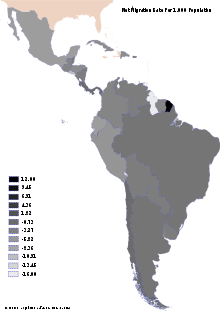African immigration to Latin America
African immigrants to Latin America include citizens and residents of countries in Latin America who were born in, or with recent ancestors from Africa. This excludes descendants of people who were forcibly transported to the Americas through the Atlantic slave trade.
Yale University published a report on the increasing immigration of people from the African continent to countries in Latin America. This report explains this trend in immigration as being due to the stricter border controls and immigration policies by countries across Europe. This report also cites rises in xenophobic sentiment across Europe as a reason for increased migration of African immigrants from Africa to Latin America.[1]
Brazil is cited as having the largest black population of any country outside of Africa. Brazil's and most of Latin America's friendly immigration policies attract migration from people from the African countries who seek to be integrated into society. Access to free healthcare and Spanish education also incentivize immigration to Latin America.[2]
History

During the Portuguese Colonial War and Angolan and Mozambican Civil Wars, a large number of Angolans and Mozambicans (including white Angolans and Mozambicans of Portuguese descent) fled to Brazil (also a former Portuguese colony, as Portugal was also a major destination for refugees) and became citizens.
After the end of both wars, most migration across the Atlantic to Latin America was from West Africa, often due to political and socioeconomic instability, and a trend toward the tightening of border security in the European Union in the 1990s and first decade of the 21st century. The process of settlement and citizenship acquisition, however, has been eased for these immigrants due to the presence of pre-existing Black diaspora populations in such countries as Brazil, which has minimized local trends towards xenophobia or colorism.[3]
By country
- Argentina - 3000 African immigrants
Brazil
- Brazil - at least 3000-4000 African immigrants (including 2000 immigrants from Nigeria)
Immigration to Brazil between the late 19th century to early 20th century
In the period between the late 19th century and the early 20th century, Brazilian immigration policy became restrictive of migration by populations from Africa in an effort to shift the population's racial demographic from being diverse to a white majority one. These policies worked by encouraging migration of people of European descent and making it difficult for people of African descent to enter the country. This same stance was imposed on Asians. These policies differed sharply from policies in the United States that enforced segregation and racial inequality. Brazil's policies were rooted in its history of interracial blending and relationships between the native people of Brazil, Europeans, and Africans. [4]
Puerto Rico
- Puerto Rico - 2,467[5]
Paraguay
In 1974, South Africa and Paraguay announced an attitude of friendship between the two states. It was the beginning of an era of friendship between countries on opposite sides of the Atlantic, coming at a period in which South Africa was isolated from the rest of the Western world which it had up to this point so depended on for support and recognition. South African efforts to form links with Latin American states was driven by a desire to oppose the world's efforts to isolate South Africa because of its policies of Apartheid. South Africa sought links with Paraguay to find new markets for its manufactured goods. [6]
White farmers fleeing revolutions in Africa
Latin American countries like Paraguay expressed an interest in attracting farmers from Southern Africa who were fleeing the possibility of majority rule, intensifying guerilla wars, and revolutionary wars for independence. Paraguay observed the expertise and experience of these farmers and expressed an interest in utilizing their technical expertise to develop land and the economy in Paraguay. Government officials traveled to Rhodesia (now Zimbabwe) to advertise the possibility of resettling of farmers to Paraguay. That visit prompted 40 Rhodesian farmers to visit Argentina to explore possibilities of farming there. At international talks, West German delegates made an offer to Latin American governments of 150 million dollars in order for them to accept 30,000 white farmers of German descended from Namibia, South Africa, and Rhodesia.[7]
See also
References
- Refugees, United Nations High Commissioner for. "Africans and Asians attracted to Latin America as a migration route". UNHCR. Retrieved 2017-12-05.
- "More African Immigrants Finding a Home in Latin America | YaleGlobal Online". yaleglobal.yale.edu. Retrieved 2017-12-05.
- Andres, Luis (2009-11-15). "African immigrants drift toward Latin America". Reuters. Retrieved 2016-06-02.
- Lauderbaugh, George. "Migration to Latin America, 1800–1914". World History Encyclopedia, Alfred J. Andrea, ABC-CLIO, 1st edition, 2011. Credo Reference, . Accessed 25 Oct 2017.
- "Archived copy". Archived from the original on December 18, 2014. Retrieved May 7, 2016.CS1 maint: archived copy as title (link)
- FIG, DAVID, and Latin America Bureau. “THE SOUTH ATLANTIC CONNECTION: GROWING LINKS BETWEEN SOUTH AFRICA AND LATIN AMERICA.” Britain and Latin America 1979: An Annual Review of British-Latin American Relations, Latin American Bureau, London, 1979, pp. 90–126. JSTOR www.jstor.org/stable/j.ctt1hj55v5.9.
- FIG, DAVID, and Latin America Bureau. “THE SOUTH ATLANTIC CONNECTION: GROWING LINKS BETWEEN SOUTH AFRICA AND LATIN AMERICA.” Britain and Latin America 1979: An Annual Review of British-Latin American Relations, Latin American Bureau, London, 1979, pp. 90–126. JSTOR, www.jstor.org/stable/j.ctt1hj55v5.9.